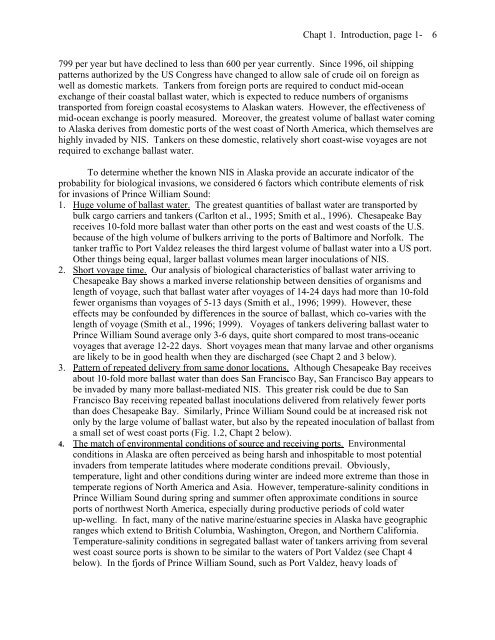Biological Invasions of Cold-Water Coastal Ecosystems - Aquatic ...
Biological Invasions of Cold-Water Coastal Ecosystems - Aquatic ...
Biological Invasions of Cold-Water Coastal Ecosystems - Aquatic ...
Create successful ePaper yourself
Turn your PDF publications into a flip-book with our unique Google optimized e-Paper software.
Chapt 1. Introduction, page 1- 6<br />
799 per year but have declined to less than 600 per year currently. Since 1996, oil shipping<br />
patterns authorized by the US Congress have changed to allow sale <strong>of</strong> crude oil on foreign as<br />
well as domestic markets. Tankers from foreign ports are required to conduct mid-ocean<br />
exchange <strong>of</strong> their coastal ballast water, which is expected to reduce numbers <strong>of</strong> organisms<br />
transported from foreign coastal ecosystems to Alaskan waters. However, the effectiveness <strong>of</strong><br />
mid-ocean exchange is poorly measured. Moreover, the greatest volume <strong>of</strong> ballast water coming<br />
to Alaska derives from domestic ports <strong>of</strong> the west coast <strong>of</strong> North America, which themselves are<br />
highly invaded by NIS. Tankers on these domestic, relatively short coast-wise voyages are not<br />
required to exchange ballast water.<br />
To determine whether the known NIS in Alaska provide an accurate indicator <strong>of</strong> the<br />
probability for biological invasions, we considered 6 factors which contribute elements <strong>of</strong> risk<br />
for invasions <strong>of</strong> Prince William Sound:<br />
1. Huge volume <strong>of</strong> ballast water. The greatest quantities <strong>of</strong> ballast water are transported by<br />
bulk cargo carriers and tankers (Carlton et al., 1995; Smith et al., 1996). Chesapeake Bay<br />
receives 10-fold more ballast water than other ports on the east and west coasts <strong>of</strong> the U.S.<br />
because <strong>of</strong> the high volume <strong>of</strong> bulkers arriving to the ports <strong>of</strong> Baltimore and Norfolk. The<br />
tanker traffic to Port Valdez releases the third largest volume <strong>of</strong> ballast water into a US port.<br />
Other things being equal, larger ballast volumes mean larger inoculations <strong>of</strong> NIS.<br />
2. Short voyage time. Our analysis <strong>of</strong> biological characteristics <strong>of</strong> ballast water arriving to<br />
Chesapeake Bay shows a marked inverse relationship between densities <strong>of</strong> organisms and<br />
length <strong>of</strong> voyage, such that ballast water after voyages <strong>of</strong> 14-24 days had more than 10-fold<br />
fewer organisms than voyages <strong>of</strong> 5-13 days (Smith et al., 1996; 1999). However, these<br />
effects may be confounded by differences in the source <strong>of</strong> ballast, which co-varies with the<br />
length <strong>of</strong> voyage (Smith et al., 1996; 1999). Voyages <strong>of</strong> tankers delivering ballast water to<br />
Prince William Sound average only 3-6 days, quite short compared to most trans-oceanic<br />
voyages that average 12-22 days. Short voyages mean that many larvae and other organisms<br />
are likely to be in good health when they are discharged (see Chapt 2 and 3 below).<br />
3. Pattern <strong>of</strong> repeated delivery from same donor locations. Although Chesapeake Bay receives<br />
about 10-fold more ballast water than does San Francisco Bay, San Francisco Bay appears to<br />
be invaded by many more ballast-mediated NIS. This greater risk could be due to San<br />
Francisco Bay receiving repeated ballast inoculations delivered from relatively fewer ports<br />
than does Chesapeake Bay. Similarly, Prince William Sound could be at increased risk not<br />
only by the large volume <strong>of</strong> ballast water, but also by the repeated inoculation <strong>of</strong> ballast from<br />
a small set <strong>of</strong> west coast ports (Fig. 1.2, Chapt 2 below).<br />
4. The match <strong>of</strong> environmental conditions <strong>of</strong> source and receiving ports. Environmental<br />
conditions in Alaska are <strong>of</strong>ten perceived as being harsh and inhospitable to most potential<br />
invaders from temperate latitudes where moderate conditions prevail. Obviously,<br />
temperature, light and other conditions during winter are indeed more extreme than those in<br />
temperate regions <strong>of</strong> North America and Asia. However, temperature-salinity conditions in<br />
Prince William Sound during spring and summer <strong>of</strong>ten approximate conditions in source<br />
ports <strong>of</strong> northwest North America, especially during productive periods <strong>of</strong> cold water<br />
up-welling. In fact, many <strong>of</strong> the native marine/estuarine species in Alaska have geographic<br />
ranges which extend to British Columbia, Washington, Oregon, and Northern California.<br />
Temperature-salinity conditions in segregated ballast water <strong>of</strong> tankers arriving from several<br />
west coast source ports is shown to be similar to the waters <strong>of</strong> Port Valdez (see Chapt 4<br />
below). In the fjords <strong>of</strong> Prince William Sound, such as Port Valdez, heavy loads <strong>of</strong>














